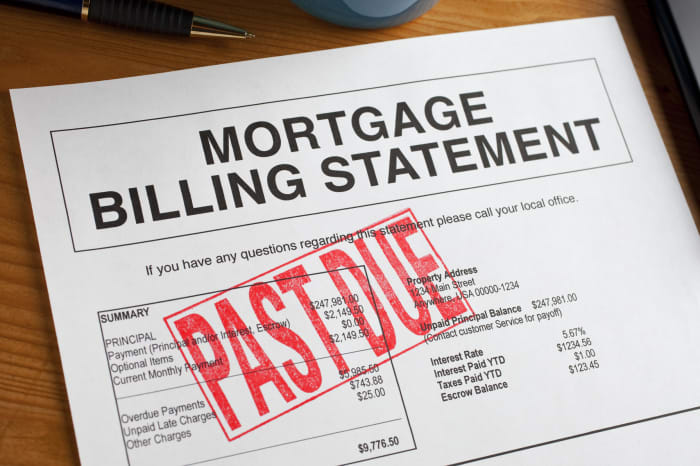Mortgage delinquencies rose for the first time in 9 months. Here’s what that means for the housing market.

More homeowners are late on their mortgage payments. What does that mean?
Getty Images/iStockphoto
Mortgage delinquencies are on the rise. Indeed, in February, the national delinquency rate rose for the first time in 9 months, largely driven by a 97,000 rise in early-stage delinquencies — or those that were 30 – 60 days past due, according to new data based on month-end mortgage performance statistics from Black Knight, a mortgage and real estate data and analytics company. The number of properties that are 30 or more days past due or in foreclosure reached approximately 1.95 million nationwide, while total U.S. foreclosure starts hit 25,000, up 541% from the same time last year, Black Knight revealed.
Why are we seeing this uptick? Mortgage delinquencies nearly disappeared during the pandemic because of the generous mortgage-relief provisions enacted by the federal government in the spring of 2020, pros explain. “Homeowners who were struggling financially got a free pass on their mortgage payments for a year or longer. Now though, homeowners have to resume payments and some can’t,” says Jeff Ostrowski, analyst at Bankrate.
But even though the total number of past-due loans rose 1.8% in February 2022 from a month earlier, it’s essential to note that the delinquency rate remains near pre-pandemic levels, with seriously delinquent mortgages, which are categorized as those being 90 or more days past due, actually falling by 72,000. This is largely due to borrowers leaving forbearance plans and returning to making payments. Although foreclosures spiked a month prior as well, they decreased 24% from January to February.
The reason delinquencies matter is because they’re a sign of distress — and that can signal weakness in the housing market. But this jump in delinquencies was minor, and experts say there’s no reason to panic. “These delinquency rates are so low that they’re not having much effect on the overall housing boom,” says Ostrowski. In fact, Matthew Speakman, Zillow senior economist, says the share of loans with payments overdue by 30 days or fewer remains very low and in line with pre-pandemic levels. “More encouragingly, the decrease in longer-term delinquencies was a reflection of the impact of rolling back pandemic-era forbearance protections. Loans in forbearance were counted as delinquent even though missed payments weren’t counted against borrowers, so as households return to making monthly payments again, serious delinquencies are falling,” says Speakman.
A bigger problem would be if the foreclosed properties linger in the market for a long period, says Lawrence Yun, chief economist at the National Association of Realtors (NAR). “But that’s not the case with many buyers ready to make a bid on most homes and especially on those discounted price foreclosed homes,” says Yun.
While delinquencies can be a leading indicator of future distressed properties reaching the market, the importance of understanding the categorization of early-stage delinquencies versus seriously delinquent mortgages reflects the difference between a temporary setback that a homeowner can recover from and a months-long delinquency that likely means the homeowner will have to move out, pros say. “The first miss on a mortgage payment could be due to an unexpected event like a job loss or a large medical expense. Often, the person finds a job to help mitigate the delinquency. If a payment is missed for 3 straight months or longer, one can expect a good number of these properties to show up as for-sale inventory,” says Yun. Gauging the timeline of delinquencies therefore dictates foreclosure rates, and that results in changes to the market. “If these homes linger in the market for a long period, there is a sense that something is not right from a consumer and local neighborhood perspective and home prices then start to decline,” says Yun.
What does this all mean for home buyers and sellers?
“A serious delinquency can be devastating for a homeowner. It means a hit to the credit score and potentially a default and foreclosure,” says Ostrowski. But because home prices are so strong right now, a struggling homeowner should be able to sell their home before losing it, though the same homeowner then has to wade through an expensive rental market.
Conversely, for buyers, delinquencies take on an entirely new meaning. “For buyers, an uptick in delinquencies is good news because it could portend more homes for sale in a housing market characterized by record-low inventories,” says Ostrowski. See the lowest mortgage rates you might qualify for here. Still, total delinquencies remain very low compared to the mid-2000s and lending standards these days are quite strict, minimizing the risk of a swell of delinquencies, notes Speakman.
Foreclosures can potentially cool down a hot market. “They increase inventory and tend to be priced lower, as servicers or municipalities may sell them at cost. This can give home buyers more options, though foreclosures can also indicate that the local economy is struggling. All these factors can make conditions more difficult for home sellers,” says Wood.



